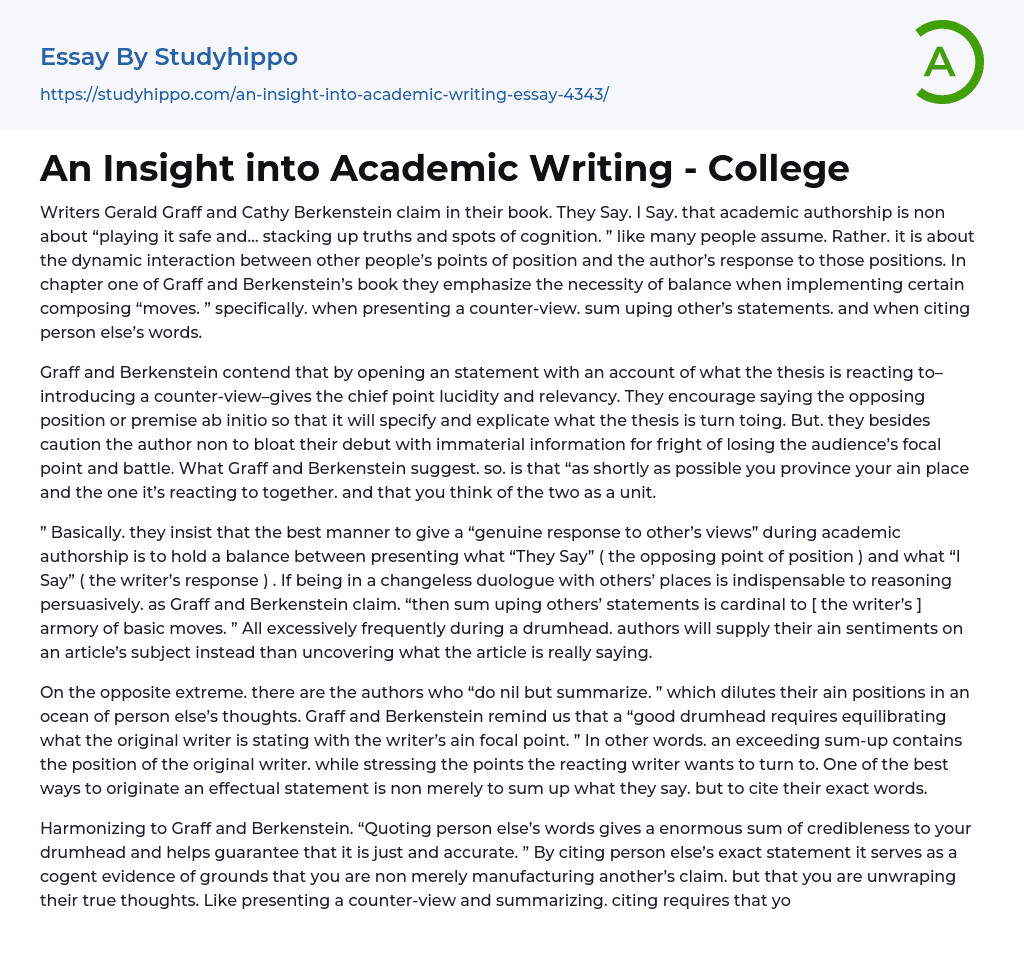Writers Gerald Graff and Cathy Berkenstein claim in their book. They Say. I Say. that academic authorship is non about “playing it safe and… stacking up truths and spots of cognition. ” like many people assume. Rather. it is about the dynamic interaction between other people’s points of position and the author’s response to those positions. In chapter one of Graff and Berkenstein’s book they emphasize the necessity of balance when implementing certain composing “moves. ” specifically. when presenting a counter-view. sum uping other’s statements. and when citing person else’s words.
Graff and Berkenstein contend that by opening an statement with an account of what the thesis is reacting to–introducing a counter-view–gives the chief point lucidity and relevancy. They encourage saying the opposing position or premise ab initio so that it
...will specify and explicate what the thesis is turn toing. But. they besides caution the author non to bloat their debut with immaterial information for fright of losing the audience’s focal point and battle. What Graff and Berkenstein suggest. so. is that “as shortly as possible you province your ain place and the one it’s reacting to together. and that you think of the two as a unit.
” Basically. they insist that the best manner to give a “genuine response to other’s views” during academic authorship is to hold a balance between presenting what “They Say” ( the opposing point of position ) and what “I Say” ( the writer’s response ) . If being in a changeless duologue with others’ places is indispensable to reasoning persuasively. as Graff and Berkenstein claim. “then sum uping others’ statements is cardinal to [ the writer’s ] armor
of basic moves. ” All excessively frequently during a drumhead. authors will supply their ain sentiments on an article’s subject instead than uncovering what the article is really saying.
On the opposite extreme. there are the authors who “do nil but summarize. ” which dilutes their ain positions in an ocean of person else’s thoughts. Graff and Berkenstein remind us that a “good drumhead requires equilibrating what the original writer is stating with the writer’s ain focal point. ” In other words. an exceeding sum-up contains the position of the original writer. while stressing the points the reacting writer wants to turn to. One of the best ways to originate an effectual statement is non merely to sum up what they say. but to cite their exact words.
Harmonizing to Graff and Berkenstein. “Quoting person else’s words gives a enormous sum of credibleness to your drumhead and helps guarantee that it is just and accurate. ” By citing person else’s exact statement it serves as a cogent evidence of grounds that you are non merely manufacturing another’s claim. but that you are unwraping their true thoughts. Like presenting a counter-view and summarizing. citing requires that you find an ideal balance between the measure of quotation marks and content of commentary.
A common issue with citing is when the writer assumes the quotation mark speaks for itself. As Graff and Berkenstein. quotation marks are like literary orphans that have been taken from their original context. “they need to be integrated into their new textual milieus. ” In simpler footings. a quotation mark needs to be introduced. interpreted. and so connected to the cardinal thought. I found chapter one of
Graff and Berkenstein’s book. “They Say. ” to be highly interesting and utile. The manner they tied all their information to a cardinal thought. while explicating how to make merely that fascinated me.
I felt like their authorship had a changeless flow from debut of a move. to implementing balance. to common jobs. how to repair those jobs. and so to exercisings that would reenforce their primary constructs. Their manner and content kept me engaged and focused. Besides. I learned a smattering of composing tactics. like presenting a counter-view. summarizing. and infixing quotation marks. that I was non one-hundred per centum sure on how to make prior to the reading. Overall. I found the chapter to be prosecuting. enlightening. and good to me and my authorship manner.
- Age Of Enlightenment essays
- Ethos essays
- Time essays
- Acceptance essays
- Meaning Of Life essays
- Reality essays
- Natural Law essays
- Political Philosophy essays
- Utilitarianism essays
- Existence essays
- Free Will essays
- Good And Evil essays
- Confucianism essays
- Relativism essays
- Conscience essays
- Environmentalism essays
- Empiricism essays
- Epistemology essays
- Ethics essays
- Existentialism essays
- Human Nature essays
- Individualism essays
- Metaphysics essays
- Philosophy Of Life essays
- Transcendentalism essays
- Truth essays
- Destiny essays
- Determinism essays
- Fate essays
- Functionalism essays
- Philosophers essays
- Pragmatism essays
- Future essays
- Child Observation essays
- Critical Reflection essays
- Teaching Philosophy essays
- Personal Philosophy essays
- Action Speak Louder Than Words essays
- Can Money Buy Happiness essays
- Values of Life essays
- Ethical dilemma essays
- Normative Ethics essays
- Virtue Ethics essays
- Belief essays
- Deontology essays
- Moral essays
- Virtue essays
- Work Ethic essays
- Henry David Thoreau essays
- Carl Jung essays




